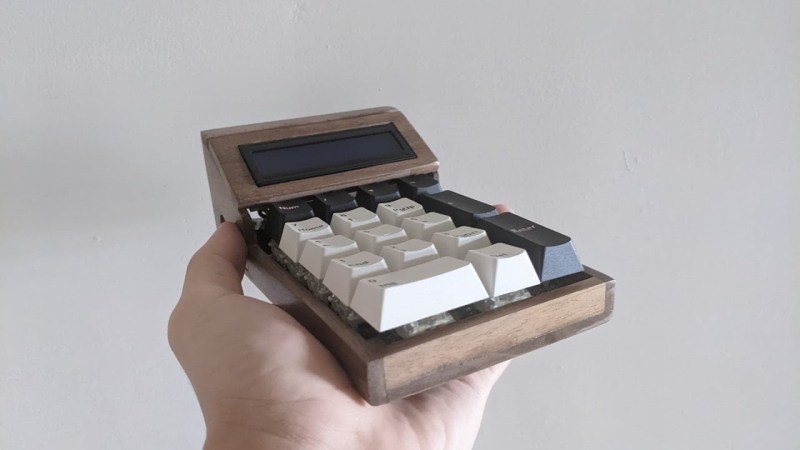There are certain design aesthetics from every era that manage to survive the fads of their time and live throughout history. Ancient Greek architecture is still drawn upon for design inspiration in modern buildings, the mid-century modern style from the 60s still inspires various designs of consumer goods, and the rounded, clean looking cars from the 90s are still highly desirable qualities in automotive design. For electronics, though, we like this 70s-inspired calculator that [Aaron] recently built.
The calculator hearkens back to the days of calculators like the HP-29C with its large buttons and dot-matrix display. [Aaron] built the case out of various woods with a screen angled towards the user, and it uses a LCD display similar to those found in antique calculators. The brain of the calculator is an Arduino which fits easily into the case, and [Aaron] also built the keyboard from scratch with Cherry MX-style mechanical keys soldered together into a custom shape.
The software to run the calculator is fairly straightforward, but we are most impressed with the woodworking, styling, and keyboard design in this build. [Aaron] is also still ironing out some bugs with the power supply as it uses a DC-DC converter to power the device from a single lithium battery. For those who are more fond of early 2000s graphing calculators instead, be sure to take a look at this graphing calculator arcade cabinet.















Nice keyboard/calc.
Those individual switch breakout boards make great sense for ergonomic keyboards where the keys are on a 3d curve. They’d also be great for optical switches; I can imagine a ws2812 type chip that can both drive LEDs and also return optical sensor state. They don’t make so much sense in this configuration IMHO.
The “Enter” key doesn’t enter…it does the job of an “=” key. Despite the display making it look like an RPN stack at work. Confused me quite a bit at first.
But the visuals are great. Remind me of the good old times when some computer peripherals actually had nice wooden cases. Well, ones with low production volumes, anyway. For mass-produced devices, like the Atari 2600, plastic cases with faux wood fronts were used.
The Sol had wood panel sides
I don’t know where he got the keys but I’d assume the used an Enter for = just as a matter of supply.
why not replace normal cheap calculator?
i dreaming about arduino and normal big caclulator and meybe usb for replace firmware and irda for email ;P
Needs red bubble 7 segment LEDs.
This looks a lot like a calculator I recall playing around with at a local department store round about 1973. It was a four-banger, not even square root, keys quite similar, but eight individual 7-segment fluorescent display tubes and plastic case. It ran on sever size C cells and cost about $100 in 1973 Dollars. I also recall playing around at about that time at the science exhibit next to the Space Needle in Seattle with an HP scientific desk calculator which had a small small green CRT display, and being fascinated with everything it could do. My guess is the price tag on that HP was probably about the same as a compact car.